第二讲 翻译定义标准语义翻译
- 格式:doc
- 大小:27.50 KB
- 文档页数:2
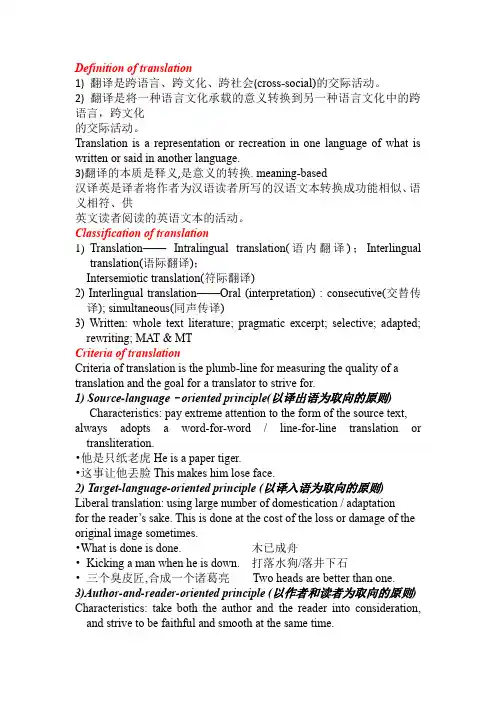
Definition of translation1) 翻译是跨语言、跨文化、跨社会(cross-social)的交际活动。
2) 翻译是将一种语言文化承载的意义转换到另一种语言文化中的跨语言,跨文化的交际活动。
Translation is a representation or recreation in one language of what is written or said in another language.3)翻译的本质是释义,是意义的转换. meaning-based汉译英是译者将作者为汉语读者所写的汉语文本转换成功能相似、语义相符、供英文读者阅读的英语文本的活动。
Classification of translation1)Translation—— Intralingual translation(语内翻译);Interlingualtranslation(语际翻译);Intersemiotic translation(符际翻译)2) Interlingual translation——Oral (interpretation) : consecutive(交替传译); simultaneous(同声传译)3) Written: whole text literature; pragmatic excerpt; selective; adapted; rewriting; MAT & MTCriteria of translationCriteria of translation is the plumb-line for measuring the quality of a translation and the goal for a translator to strive for.1) Source-language–oriented principle(以译出语为取向的原则)Characteristics: pay extreme attention to the form of the source text, always adopts a word-for-word / line-for-line translation or transliteration.•他是只纸老虎He is a paper tiger.•这事让他丢脸This makes him lose face.2) Target-language-oriented principle (以译入语为取向的原则) Liberal translation: using large number of domestication / adaptationfor the reader’s sake. This is done at the cost of the loss or damage of the original image sometimes.•What is done is done. 木已成舟•Kicking a man when he is down. 打落水狗/落井下石•三个臭皮匠,合成一个诸葛亮Two heads are better than one.3)Author-and-reader-oriented principle (以作者和读者为取向的原则) Characteristics: take both the author and the reader into consideration, and strive to be faithful and smooth at the same time.•繁华也罢,贫穷也罢,丈夫和妻子携手一生,情深意长。

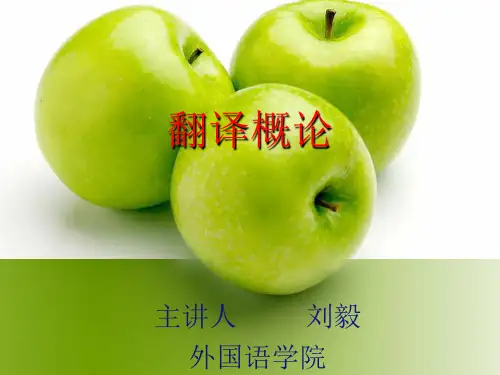
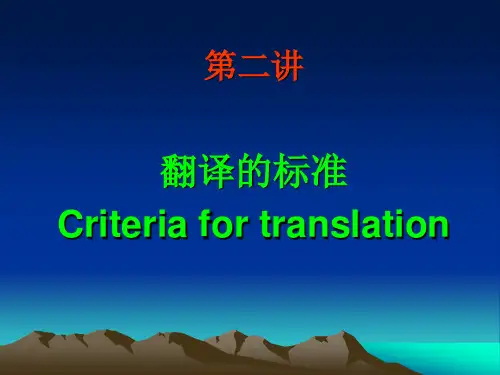

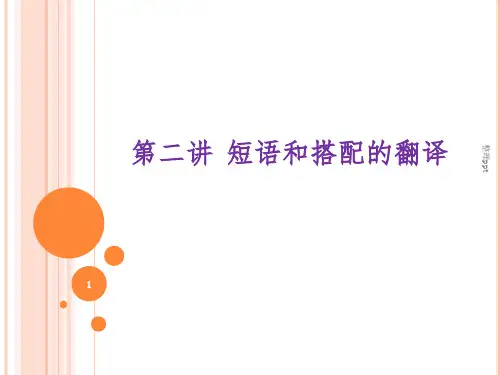
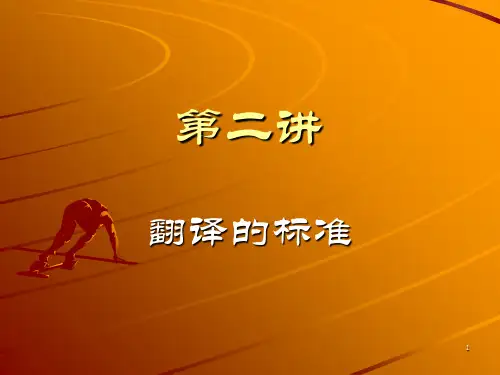
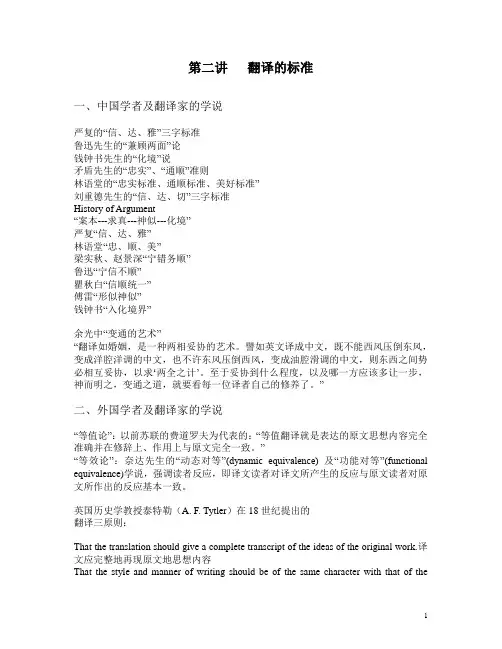
第二讲翻译的标准一、中国学者及翻译家的学说严复的“信、达、雅”三字标准鲁迅先生的“兼顾两面”论钱钟书先生的“化境”说矛盾先生的“忠实”、“通顺”准则林语堂的“忠实标准、通顺标准、美好标准”刘重德先生的“信、达、切”三字标准History of Argument“案本---求真---神似---化境”严复“信、达、雅”林语堂“忠、顺、美”梁实秋、赵景深“宁错务顺”鲁迅“宁信不顺”瞿秋白“信顺统一”傅雷“形似神似”钱钟书“入化境界”余光中“变通的艺术”“翻译如婚姻,是一种两相妥协的艺术。
譬如英文译成中文,既不能西风压倒东风,变成洋腔洋调的中文,也不许东风压倒西风,变成油腔滑调的中文,则东西之间势必相互妥协,以求…两全之计‟。
至于妥协到什么程度,以及哪一方应该多让一步,神而明之,变通之道,就要看每一位译者自己的修养了。
”二、外国学者及翻译家的学说“等值论”:以前苏联的费道罗夫为代表的:“等值翻译就是表达的原文思想内容完全准确并在修辞上、作用上与原文完全一致。
”“等效论”:奈达先生的“动态对等”(dynamic equivalence) 及“功能对等”(fun ctional equivalence)学说,强调读者反应,即译文读者对译文所产生的反应与原文读者对原文所作出的反应基本一致。
英国历史学教授泰特勒(A. F. Tytler)在18世纪提出的翻译三原则:That the translation should give a complete transcript of the ideas of the original work.译文应完整地再现原文地思想内容That the style and manner of writing should be of the same character with that of theoriginal. 译文地风格、笔调应与原文的性质相同That the translation should have all the ease of the original composition. 译文应像原文一样流畅自然三、三类翻译原则1. 以作者或读者两方中某一方为主要着眼点的原则中国汉唐时期的“文”与“质”之争(实际上是意译与直译之争)主张“文”的翻译家强调翻译的修辞和通顺强调译文的可读性(意译);主张“质”的翻译家则强调翻译的不增不减,强调翻译的忠实性(直译,甚至是硬译)。
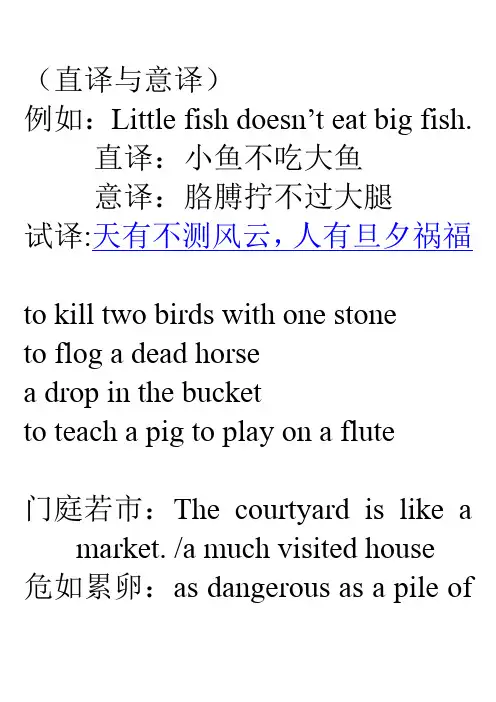
(直译与意译)例如:Little fish doesn’t eat big fish.直译:小鱼不吃大鱼意译:胳膊拧不过大腿试译:天有不测风云,人有旦夕祸福to kill two birds with one stoneto flog a dead horsea drop in the bucketto teach a pig to play on a flute门庭若市:The courtyard is like a market. /a much visited house危如累卵:as dangerous as a pile ofeggs/great insecurity; hazardousin the extreme由于文化对语言的影响,有些语言成分只能意译,而不能直译,这主要体现在受本国文化影响最深的成语和谚语上。
hand in glove with:和...狼狈为奸once in a blue moon: 千载难逢乱七八糟:at sixes and sevens (seven disorders and eight chaos)招风惹草:look for trouble (invite wind to exasperate the grass)It is an ill bird that fouls its own nest.外甥打灯笼---照舅(旧)归化与异化(domestication/adaptation orforeignization / alienation)归化的翻译在理论上是把语言看作交际工具;在实践上,强调通俗易懂,避免多义或歧义。
习惯认为,当原文与译文之间因文化差异而出现不能通达的情况时,“要用译语文化替代原语文化”即把在译语中找不到对等的外语词汇改头换面,或套用译语中与之相似的现成的表达法,把它们变成读者熟悉的译语文化形象。
归化派代表人物尤金•奈达(Eugene A. Nida): Functional Equivalence 功能对等“The receptors of the translated text could respond to it with comprehension and appreciation in essentially the samemanner and to the same degree as the original receptors of the message”;“Translation should arouse the same feeling in its receptors as the feeling of the readers of the original”---- NidaFor instance: as white as snow 通常译为白如雪/ 但没有见过雪的人可以将其翻译为“白如白鹭毛”,以达到功能对等的目的。

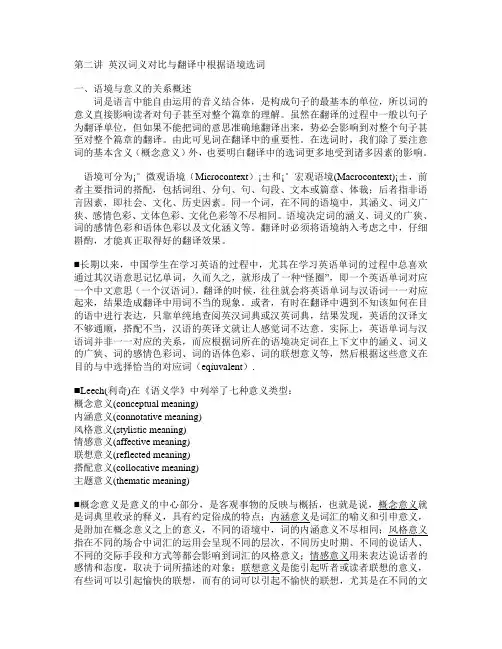
第二讲英汉词义对比与翻译中根据语境选词一、语境与意义的关系概述词是语言中能自由运用的音义结合体,是构成句子的最基本的单位,所以词的意义直接影响读者对句子甚至对整个篇章的理解。
虽然在翻译的过程中一般以句子为翻译单位,但如果不能把词的意思准确地翻译出来,势必会影响到对整个句子甚至对整个篇章的翻译。
由此可见词在翻译中的重要性。
在选词时,我们除了要注意词的基本含义(概念意义)外,也要明白翻译中的选词更多地受到诸多因素的影响。
语境可分为¡°微观语境(Microcontext)¡±和¡°宏观语境(Macrocontext)¡±,前者主要指词的搭配,包括词组、分句、句、句段、文本或篇章、体裁;后者指非语言因素,即社会、文化、历史因素。
同一个词,在不同的语境中,其涵义、词义广狭、感情色彩、文体色彩、文化色彩等不尽相同。
语境决定词的涵义、词义的广狭、词的感情色彩和语体色彩以及文化涵义等。
翻译时必须将语境纳入考虑之中,仔细斟酌,才能真正取得好的翻译效果。
⏹长期以来,中国学生在学习英语的过程中,尤其在学习英语单词的过程中总喜欢通过其汉语意思记忆单词,久而久之,就形成了一种“怪圈”,即一个英语单词对应一个中文意思(一个汉语词),翻译的时候,往往就会将英语单词与汉语词一一对应起来,结果造成翻译中用词不当的现象。
或者,有时在翻译中遇到不知该如何在目的语中进行表达,只靠单纯地查阅英汉词典或汉英词典,结果发现,英语的汉译文不够通顺,搭配不当,汉语的英译文就让人感觉词不达意。
实际上,英语单词与汉语词并非一一对应的关系,而应根据词所在的语境决定词在上下文中的涵义、词义的广狭、词的感情色彩词、词的语体色彩、词的联想意义等,然后根据这些意义在目的与中选择恰当的对应词(eqiuvalent).⏹Leech(利奇)在《语义学》中列举了七种意义类型:概念意义(conceptual meaning)内涵意义(connotative meaning)风格意义(stylistic meaning)情感意义(affective meaning)联想意义(reflected meaning)搭配意义(collocative meaning)主题意义(thematic meaning)⏹概念意义是意义的中心部分,是客观事物的反映与概括,也就是说,概念意义就是词典里收录的释义,具有约定俗成的特点;内涵意义是词汇的喻义和引申意义,是附加在概念意义之上的意义,不同的语境中,词的内涵意义不尽相同;风格意义指在不同的场合中词汇的运用会呈现不同的层次,不同历史时期、不同的说话人、不同的交际手段和方式等都会影响到词汇的风格意义;情感意义用来表达说话者的感情和态度,取决于词所描述的对象;联想意义是能引起听者或读者联想的意义,有些词可以引起愉快的联想,而有的词可以引起不愉快的联想,尤其是在不同的文化中,词的联想意义有很大的区别。
翻译理论一、翻译定义:1. 张培基——翻译是用一种语言把另一种语言所表达的思维内容准确而完整地重新表达出来的语言活动。
3. 刘宓庆——翻译的实质是语际的意义转换。
4. 王克非——翻译是将一种语言文字所蕴含的意思用另一种语言文字表达出来的文化活动。
5. 泰特勒——好的翻译应该是把原作的长处完全地移注到另一种语言,以使译入语所属国家的本地人能明白地领悟、强烈地感受,如同使用原作语言的人所领悟、所感受的一样。
6. 费道罗夫——翻译就是用一种语言把另一种语言在内容与形式不可分割的统一中所业已表达出来的东西准确而完全地表达出来。
7. 卡特福德——翻译的定义也可以这样说:把一种语言(Source Language)中的篇章材料用另一种语言(Target Language)中的篇章材料来加以代替。
8. 奈达——翻译就是在译入语中再现与原语信息最切近的自然对等物,首先就意义而言,其次就是文体而言。
9. 巴尔胡达罗夫——翻译是把一种语言的语言产物在保持内容方面(也就是意义)不变的情况下改变为另一种语言的语言产物的过程。
纽马克——通常(虽然不能说总是如此),翻译就是把一个文本的意义按作者所想的方式移译入另一种文字(语言)。
10. “Translation is the expression in one language (ortarget language译入语) of what hasbeen expressed in anotherlanguage (source language 原语), preserving semantic and stylisticequivalences.”--- Dubois11. “Translating consists in reproducing in thereceptor language the closest naturalequivalent of the source languagemessage, first in terms of meaning and secondly in terms of style.”---EugeneNida12. “Translation is a craft consisting in the attemptto replace a written message and/or statement in one language by the samemessage and/or statement in another language.”---Peter Newmark13.Translation or translating is a communicativeactivity or dynamic process in which the translator makes great effort tothoroughly comprehend a written message or text in the sourcelanguage andworks very hard to achieve an adequate or an almost identical reproduction inthetarget language version of the written source language message or text.二、翻译标准1. 翻译的标准概括为言简意赅的四个字:“忠实(faithfulness)、通顺(smoothness)”。
第二讲:翻译的定义及标准、语义翻译(2)一.什么是翻译?---翻译是一门艺术,是语言艺术的再创作。
如果把写作比成自由舞蹈,翻译就是带着手铐脚镣在跳舞,而且还要跳得优美。
---翻译是技能,再现原文信息时,为避免信息的损失,力戒欠额翻译(undertranslation)和过载翻译(overtranslation),译者要采用增词,减词,引申,并句和分句等技巧。
---翻译是在译语中用最切近而又最自然的对等语再现源语的信息,首先是意义对等,其次是文体对等。
二.翻译的教学标准《高等学校英语专业高年级英语教学大纲》规定,英汉翻译的评估项目标为:A.忠实:“原文信息全部传达,语气和文体风格与原文相一致”60%B.通顺:“断句恰当,句式正确,选词妥贴”40%三.翻译技巧(2):语义翻译(2)---翻译时应当注意词义的褒贬。
翻译时,必须正确理解原作者的基本立场和观点,然后选用适当的语言手段译出。
原文中词语的褒贬意义,要根据上下文恰如其分地表达出来,即使有些词语孤立起来看似乎是中性的。
Eg.As a demanding boss, he expected total loyalty and dedication.She is a demanding teacher, yet she’s very kind to her students.John was an aggressive salesman who did his job quite well.Hitler pursued an aggressive policy after he seized power.四.翻译练习(2)I. Translate the following sentences, paying attention to the choice of words.1.She is fidgety and restless.2.All the inventors have a restless mind.3.They incited him to go into further investigation.4.The plotters incited the soldiers to rise against their officers.5.The general has the reputation of being courageous.6.He was an honest man, but unfortunately he had a certain reputation.II. Improve the following translations based on the principle of faithfulness and fluency.1.I have read your articles. I expected to meet an older man.我拜读过你的文章,我期望可以找到一个年纪稍长的人。
第二讲:翻译的定义及标准、语义翻译(2)
一.什么是翻译?
---翻译是一门艺术,是语言艺术的再创作。
如果把写作比成自由舞蹈,翻译就是带着手铐脚镣在跳舞,而且还要跳得优美。
---翻译是技能,再现原文信息时,为避免信息的损失,力戒欠额翻译(undertranslation)和过载翻译(overtranslation),译者要采用增词,减词,引申,并句和分句等技巧。
---翻译是在译语中用最切近而又最自然的对等语再现源语的信息,首先是意义对等,其次是文体对等。
二.翻译的教学标准
《高等学校英语专业高年级英语教学大纲》规定,英汉翻译的评估项目标为:
A.忠实:“原文信息全部传达,语气和文体风格与原文相一致”60%
B.通顺:“断句恰当,句式正确,选词妥贴”40%
三.翻译技巧(2):
语义翻译(2)---翻译时应当注意词义的褒贬。
翻译时,必须正确理解原作者的基本立场和观点,然后选用适当的语言手段译出。
原文中词语的褒贬意义,要根据上下文恰如其分地表达出来,即使有些词语孤立起来看似乎是中性的。
Eg.
As a demanding boss, he expected total loyalty and dedication.
She is a demanding teacher, yet she’s very kind to her students.
John was an aggressive salesman who did his job quite well.
Hitler pursued an aggressive policy after he seized power.
四.翻译练习(2)
I. Translate the following sentences, paying attention to the choice of words.
1.She is fidgety and restless.
2.All the inventors have a restless mind.
3.They incited him to go into further investigation.
4.The plotters incited the soldiers to rise against their officers.
5.The general has the reputation of being courageous.
6.He was an honest man, but unfortunately he had a certain reputation.
II. Improve the following translations based on the principle of faithfulness and fluency.
1.I have read your articles. I expected to meet an older man.
我拜读过你的文章,我期望可以找到一个年纪稍长的人。
2.They ran away as fast as their legs could carry them.
他们跑得像他们的腿所能载动他们那样的快。
3.I will go and attend the reception, if only to make some new friends.
我将去参加招待会,但只是为了交些新朋友。
4.When she and he met again, each had been married to another.
当再次相见时,每个人都结婚了。
5.The present situation is that many staff consider impossible what is really possible if effort is
made.
很多职员认为最有可能的事情努力后也还是不可能的。
五、实用翻译(2):商标的翻译
1.音译:
当商标是专有名词(人名,地名等)时,由于这些词本身没有多少意思,故常使用音译的方法。
Eg. Kodak(柯达), Casio(卡西欧), Changhong(长虹)
2.意译
将原商标的意思用译入语表示出来。
采用灵活对等的翻译原则,即意思与原商标基本一致,且符合商标词短小简洁的特点。
如:V olkswagen大众(汽车),Shell壳牌(石油),Camel骆驼(香烟)
3. 音意兼顾
以原商标的音为基础,在译入语中找到发音与原文相同或相似,同时又反映出产品一定特性的词汇。
如:
CocaCola可口可乐,Benz奔驰,广百Grandbuy,Ikea宜家
4.不译或部分译
如:IBM公司,Remy Martin X. O人头马XO。